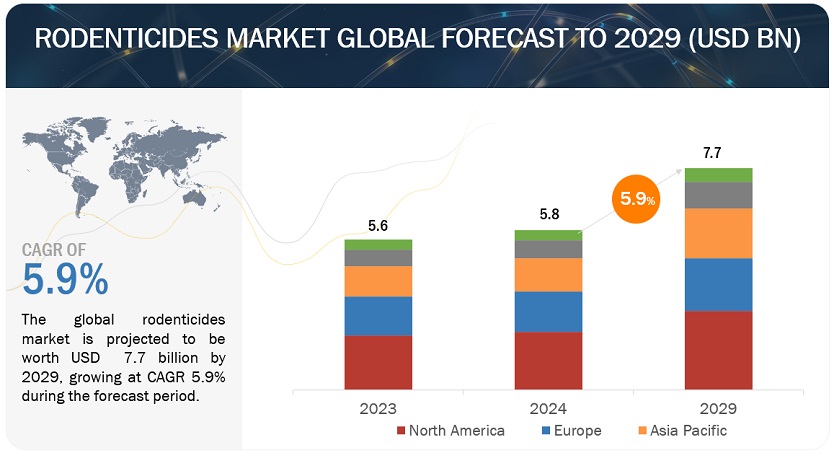According to a research report “Rodenticides Market by Type (Anticoagulants, Non-Coagulants), Mode of Application (Pellets, Spray, and Powder), End Use (Agriculture, Warehouses, Urban Centers), Rodent Types (Rats, Mice, Chipmunks, Hamsters) & Region – Global Forecast to 2029” published by MarketsandMarkets, the global market for rodenticides is estimated at USD 5.8 billion in 2024 and is projected to reach USD 7.7 billion by 2029, at a CAGR of 5.9% during the forecast period.

Download PDF Brochure: https://www.marketsandmarkets.com/pdfdownloadNew.asp?id=189089498
By end use, urban centers are estimated to grow at the highest rate in the rodenticides market.
The rodenticides market is witnessing a significant surge in interest and investment, with its end use in urban centers emerging as a key driver of this growth. The abundance of easily accessible food sources in urban settings, such as overflowing trash cans, spilled grains, and accessible pet food, attracts and sustains larger rodent populations compared to rural areas, where there is less waste and more natural predators. This dynamic is likely to influence the demand for rodenticides, as urban environments may require more intensive rodent control measures to manage the larger populations effectively. Rodents are vectors for various diseases, including leptospirosis, hantavirus, and plague. To minimize the risk of disease transmission to humans and pets, rodent control measures, including the use of rodenticides, are often implemented in urban centers.
By mode of application, pellet form accounted for the largest share in 2023 in terms of value.
Pellet-based rodenticides offer ease of handling and application, catering to the needs of professionals and homeowners alike. They can be easily placed in bait stations, trays, or directly inserted into rodent burrows. Pellet-based rodenticides generally exhibit a longer shelf life in contrast to alternative formulations like liquid or gel baits. This quality renders them suitable for prolonged storage and usage, thereby minimizing the necessity for frequent replacements. Pellet-based rodenticides frequently demonstrate greater resistance to environmental factors like moisture and humidity when compared to other bait varieties. This durability guarantees the effectiveness of the bait even under challenging weather conditions. These factors have led to an increase in the application of pellets form of rodenticides amongst others.
By rodent type, mice are estimated to grow at the highest rate in the rodenticide market.
Mice possess a global presence and exhibit adaptability across a spectrum of environments, spanning from urban settings to rural expanses. Their capacity to flourish in diverse habitats renders them prevalent inhabitants across numerous regions. Due to their high reproductive rate, female mice can produce multiple litters within a single year. This swift breeding cycle facilitates the rapid expansion of mouse populations, potentially resulting in widespread infestations if not effectively managed. Mice exhibit omnivorous behavior, opportunely consuming a wide array of foods such as grains, seeds, fruits, and insects. Their adaptable dietary preferences play a pivotal role in their capability to survive and thrive across diverse environments. These factors have led the mice in the rodent type segment to grow at the highest CAGR in the rodenticides market.
Make an Inquiry: https://www.marketsandmarkets.com/Enquiry_Before_BuyingNew.asp?id=189089498
The Asia Pacific region is projected for the fastest growth in terms of value.
The rodenticides market in the Asia Pacific region is experiencing robust growth driven by several key factors. Rapid urbanization and industrialization in the Asia Pacific region are fostering the expansion of urban areas, industrial facilities, and agricultural lands. These thriving environments create ideal conditions for rodent infestations to thrive. Consequently, there’s a growing demand for rodenticides to effectively manage pest populations in these settings. Numerous countries in the Asia Pacific region have significant agricultural sectors characterized by large-scale crop cultivation and extensive storage facilities. However, rodents represent a considerable menace to agricultural productivity due to their propensity to inflict damage on crops and contaminate food stores. Consequently, there is a pressing need for rodenticides to mitigate these pests and safeguard agricultural yields.
In summary, the growth of the rodenticides market in the Asia Pacific is propelled by increasing urbanization and the growing agriculture sector.
Key players in this market include BASF SE (Germany), Bayer AG (Germany), Syngenta AG (Switzerland), UPL ( India), Neogen Corporation ( US), Anticimex ( Sweden), Ecolab (US), Rentokil Initial plc ( UK), Senestech, Inc. ( US), Rollins, Inc. ( US), Liphatech, Inc. (US), JT Eaton & Co., Inc. (US), PelGar International (UK), Bell Laboratories Inc. (US) and Abell Pest Control ( Canada).


